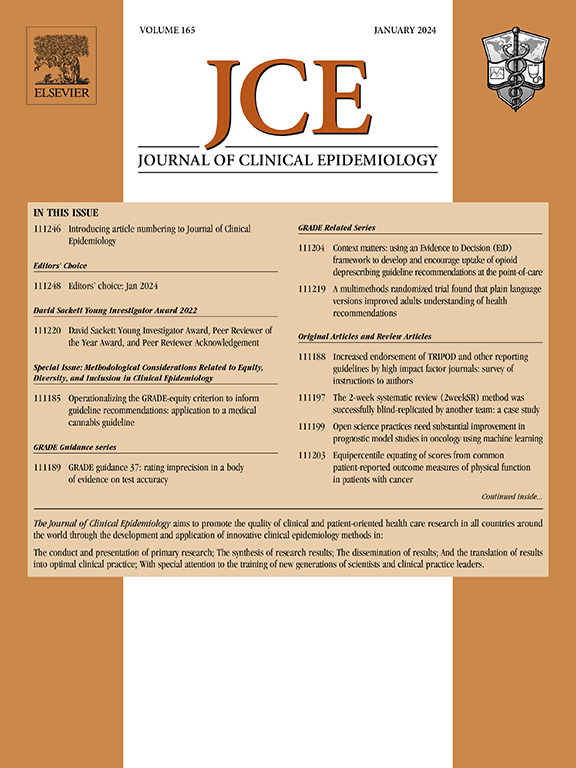基于人工智能的临床预测模型的更新方法:范围综述。
IF 7.3
2区 医学
Q1 HEALTH CARE SCIENCES & SERVICES
引用次数: 0
摘要
目的:综述基于新数据更新人工智能临床预测模型的方法。研究设计和设置:我们全面检索了截至2022年8月的Scopus和EMBASE,以获取有关预测模型更新方法的发展、描述或评估的文章。我们特别关注了医学领域中涉及基于人工智能的预测模型的文章,这些模型是根据新数据更新的,不包括基于回归的更新方法,因为这些方法在其他地方已经被广泛讨论过。我们分类并描述了用于更新基于人工智能的预测模型的识别方法,以及使用它们的用例。结果:我们纳入了78篇文章。大多数纳入的文章讨论了以医学图像作为输入数据(65.4%)的神经网络方法的更新(93.6%)。在现有的许多文章(51.3%)中,针对广泛任务的预训练模型被更新为执行专门的临床任务。更新模型的其他常见原因是为了解决数据随时间的变化和跨中心差异;但是,还确定了更多独特的用例,例如将模型从广泛的人群更新为特定的个体。我们将确定的模型更新方法分为四类:神经网络特定方法(92.3%的文章中有描述),集成特定方法(2.5%),模型不可知方法(9.0%)和其他(1.3%)。神经网络专用方法的变化进一步分类基于:(1)原始神经网络的保留部分,(2)原始神经网络是否以及如何使用新参数进行扩展,(3)原始神经网络参数对新数据的调整程度。最常见的方法(n=30)涉及选择现有神经网络的第一层,附加新的,随机初始化的层,然后优化整个神经网络。结论:我们确定了许多方法来调整或更新基于人工智能的预测模型,这些模型基于各种各样的用例。在临床预测研究中,除了神经网络(如随机森林)之外,基于人工智能的预测模型的更新方法似乎还没有得到充分的探索。本文章由计算机程序翻译,如有差异,请以英文原文为准。
Updating methods for artificial intelligence–based clinical prediction models: a scoping review
Objectives
To give an overview of methods for updating artificial intelligence (AI)-based clinical prediction models based on new data.
Study Design and Setting
We comprehensively searched Scopus and Embase up to August 2022 for articles that addressed developments, descriptions, or evaluations of prediction model updating methods. We specifically focused on articles in the medical domain involving AI-based prediction models that were updated based on new data, excluding regression-based updating methods as these have been extensively discussed elsewhere. We categorized and described the identified methods used to update the AI-based prediction model as well as the use cases in which they were used.
Results
We included 78 articles. The majority of the included articles discussed updating for neural network methods (93.6%) with medical images as input data (65.4%). In many articles (51.3%) existing, pretrained models for broad tasks were updated to perform specialized clinical tasks. Other common reasons for model updating were to address changes in the data over time and cross-center differences; however, more unique use cases were also identified, such as updating a model from a broad population to a specific individual. We categorized the identified model updating methods into four categories: neural network-specific methods (described in 92.3% of the articles), ensemble-specific methods (2.5%), model-agnostic methods (9.0%), and other (1.3%). Variations of neural network-specific methods are further categorized based on the following: (1) the part of the original neural network that is kept, (2) whether and how the original neural network is extended with new parameters, and (3) to what extent the original neural network parameters are adjusted to the new data. The most frequently occurring method (n = 30) involved selecting the first layer(s) of an existing neural network, appending new, randomly initialized layers, and then optimizing the entire neural network.
Conclusion
We identified many ways to adjust or update AI-based prediction models based on new data, within a large variety of use cases. Updating methods for AI-based prediction models other than neural networks (eg, random forest) appear to be underexplored in clinical prediction research.
Plain Language Summary
AI-based prediction models are increasingly used in health care, helping clinicians with diagnosing diseases, guiding treatment decisions, and informing patients. However, these prediction models do not always work well when applied to hospitals, patient populations, or times different from those used to develop the models. Developing new models for every situation is neither practical nor desired, as it wastes resources, time, and existing knowledge. A more efficient approach is to adjust existing models to new contexts (‘updating’), but there is limited guidance on how to do this for AI-based clinical prediction models. To address this, we reviewed 78 studies in detail to understand how researchers are currently updating AI-based clinical prediction models, and the types of situations in which these updating methods are used. Our findings provide a comprehensive overview of the available methods to update existing models. This is intended to serve as guidance and inspiration for researchers. Ultimately, this can lead to better reuse of existing models and improve the quality and efficiency of AI-based prediction models in health care.
求助全文
通过发布文献求助,成功后即可免费获取论文全文。
去求助
来源期刊

Journal of Clinical Epidemiology
医学-公共卫生、环境卫生与职业卫生
CiteScore
12.00
自引率
6.90%
发文量
320
审稿时长
44 days
期刊介绍:
The Journal of Clinical Epidemiology strives to enhance the quality of clinical and patient-oriented healthcare research by advancing and applying innovative methods in conducting, presenting, synthesizing, disseminating, and translating research results into optimal clinical practice. Special emphasis is placed on training new generations of scientists and clinical practice leaders.
 求助内容:
求助内容: 应助结果提醒方式:
应助结果提醒方式:


